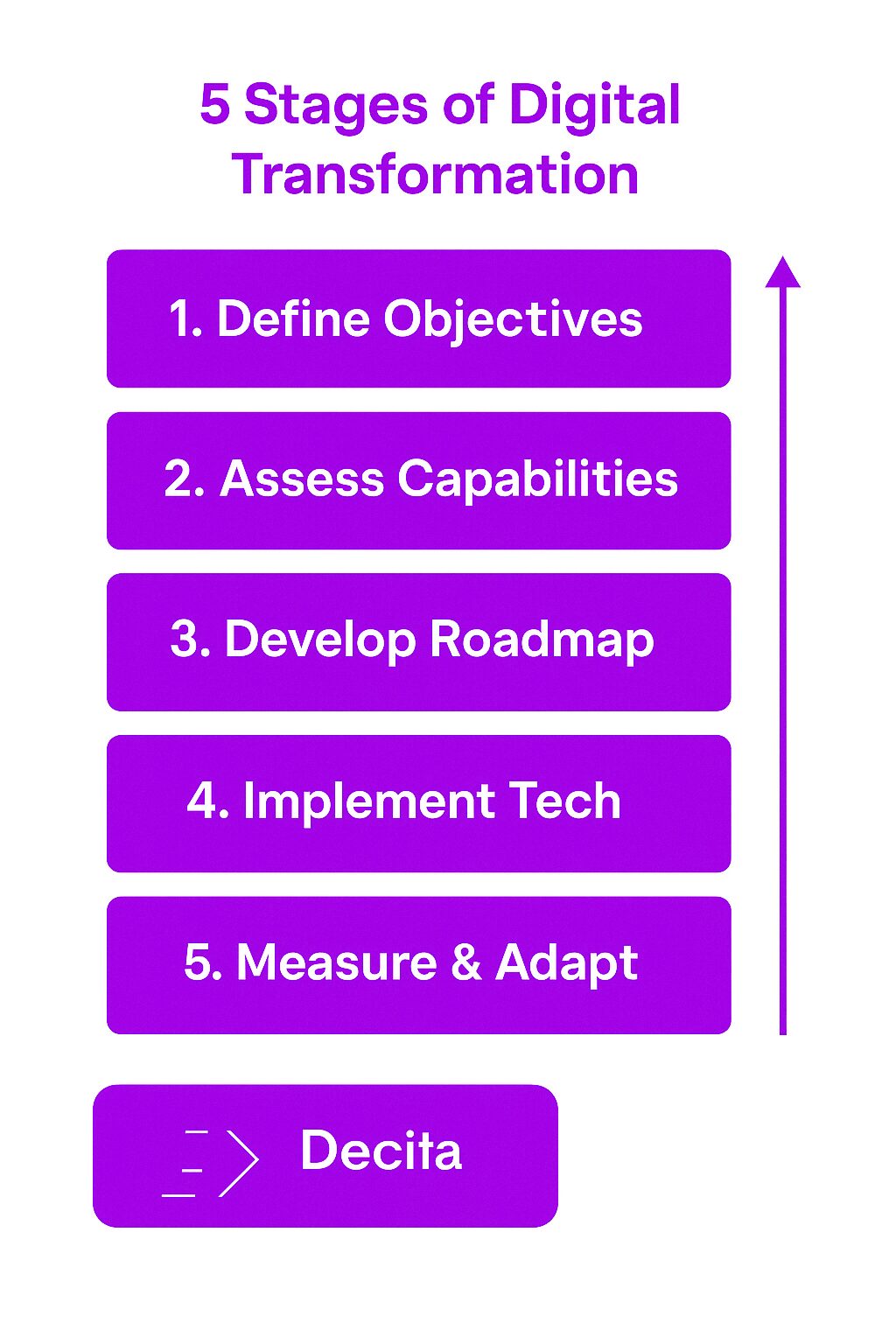What Is a Digital Transformation Strategy?
A digital transformation strategy is a structured plan that organizations use to integrate digital technologies into their operations, culture, and business models. It ensures that businesses adopt digital solutions with clear objectives, aligning technology with broader company goals and business strategy to achieve long-term success. Rather than just implementing new tools, digital transformation is about rethinking how a company operates, serves customers, and creates value.
A well-defined strategy enables businesses to stay competitive in a fast-evolving market, meet changing customer expectations, and optimize internal workflows. Without a plan, digital initiatives can become fragmented, leading to inefficiencies, wasted investments, and employee resistance.
How a Digital Transformation Strategy Works
Digital transformation efforts are not simply about adopting new software—they involve reengineering business processes, improving customer experiences, and leveraging data for better decision-making. A strategy provides a roadmap that guides this transition in a structured and measurable way.
A strong digital transformation strategy typically addresses:
-
Technology integration – Implementing new systems and upgrading outdated infrastructure.
-
Workforce enablement – Ensuring employees can effectively use digital tools.
-
Process automation – Reducing manual inefficiencies through AI and automation.
-
Customer experience enhancement – Delivering seamless digital interactions across touchpoints.
-
Data-driven decision-making – Leveraging analytics to refine strategies and operations.
Key Stages of Digital Transformation

1. Defining Objectives and Vision
Organizations must establish clear digital strategies for transformation. These may include improving operational efficiency, enhancing customer experience, or driving revenue growth. Leadership should align digital initiatives with broader business objectives.
2. Assessing Current Capabilities
Before implementing new digital initiatives, companies must evaluate existing tools, processes, and workforce digital skills. Identifying gaps helps prioritize investment areas.
3.3 3. **Developing a Digital Transformation Roadmap**
A well-structured digital transformation roadmap outlines:
-
Key milestones and timelines
-
Required technology investments
-
Change management strategies
-
Training programs for employees
4. Implementing Technology Solutions
Businesses deploy new digital tools such as cloud computing, automation, and artificial intelligence, leveraging technology for seamless integration. Ensuring seamless integration across platforms is crucial.
5. Measuring Progress and Adapting
Continuous monitoring of key performance indicators (KPIs) ensures that digital transformation initiatives achieve their intended outcomes. Companies must be agile, refining strategies based on real-time data and employee feedback.
Why Digital Transformation Strategies Are Important
Organizations that lack a strategic approach to digital transformation face several risks, including inefficiencies, wasted investments, and employee resistance. A strong strategy helps businesses achieve measurable business value by:
-
Staying competitive – Companies that adapt quickly to digital trends outperform those that resist change.
-
Enhancing customer experience – Digital-first businesses provide seamless, personalized customer interactions.
-
Improving efficiency – Automation and digital workflows reduce costs and increase productivity.
-
Ensuring workforce readiness – Training programs help employees embrace new technologies.
Without a clear strategy, businesses struggle to implement digital solutions effectively, leading to fragmented efforts and underwhelming results.
Benefits of a Digital Transformation Strategy
1. Operational Efficiency
Automating manual processes and leveraging cloud-based solutions streamline workflows, reducing operational bottlenecks.
2. Data-Driven Decision-Making
Organizations with digital transformation strategies use real-time analytics to make informed decisions, improving agility and responsiveness.
3. Enhanced Customer Experience
Digital-first strategies ensure businesses provide smooth, omnichannel experiences for customers, leading to higher satisfaction and retention rates.
4. Improved Employee Collaboration
Integrated digital tools enhance teamwork, especially in remote and hybrid work environments.
5. Stronger Market Positioning
Businesses that lead in digital transformation achieve successful digital transformation and gain a competitive edge by leveraging AI, machine learning, and automation to innovate faster than competitors.
Challenges of Digital Transformation
1. Employee Resistance to Change
Many employees fear that digital transformation will replace jobs or disrupt workflows, which can significantly impact the organization’s digital transformation. Organizations must implement change management strategies to address these concerns.
2. Technology Silos
Legacy systems that don’t integrate with modern solutions can create inefficiencies. Companies must ensure seamless system integration.
3. Budget Constraints
Digital transformation requires investment in new tools, infrastructure, and training. Organizations must balance costs with long-term benefits.
4. Security and Compliance Risks
With increased reliance on digital systems, cybersecurity threats and regulatory compliance become major concerns.
5. Lack of Expertise
Not all companies have the internal technical expertise to implement digital transformation successfully. Partnering with external consultants or investing in workforce training can help bridge this gap.
Best Practices for Digital Transformation Success
1. Align Digital Strategy with Business Goals
Ensure digital initiatives directly contribute to core business objectives, such as revenue growth, operational efficiency, or customer engagement. Aligning digital strategy with business goals is a critical part of the transformation process, ensuring that technology investments optimize business processes and foster effective team collaboration.
2. Secure Leadership Buy-In
Digital transformation requires strong executive support to drive adoption and resource allocation.
3. Focus on User Experience
Whether for employees or customers, digital tools should be intuitive and accessible, minimizing learning curves and frustration.
4. Implement Agile Methodologies
Rather than executing transformation in a single, large-scale overhaul, businesses should use iterative approaches to test and refine initiatives.
5. Invest in Training and Support
Workforce education is critical to digital transformation success. Employees need ongoing training to stay proficient in new systems.
Real-World Examples of Digital Transformation Strategy
1. Retail: Amazon’s AI-Driven Personalization
Amazon’s digital transformation strategy integrates AI-powered recommendations, automated warehouses, and seamless e-commerce experiences to enhance customer satisfaction.
2. Healthcare: Telemedicine Adoption
Hospitals and clinics worldwide have implemented telehealth solutions, allowing remote patient consultations and AI-assisted diagnostics to improve accessibility and efficiency.
3. Banking: Digital-Only Financial Services
Traditional banks and fintech companies are transforming the banking experience by offering mobile banking, AI-powered fraud detection, and blockchain security.
4. Manufacturing: Smart Factories
Companies like Siemens and GE leverage digital transformation frameworks, IoT-connected machinery, and AI-driven analytics to optimize production lines and reduce downtime.
Related Sub-Concepts
1. Digital Adoption
Digital adoption, as a critical part of the digital transformation journey, ensures that employees and customers effectively use digital tools, maximizing the impact of transformation initiatives.
2. Change Management
A structured approach to guiding employees through digital changes helps minimize resistance and improve adoption.
3. Business Process Automation
The use of AI and automation tools to streamline repetitive processes reduces costs and improves efficiency.
4. Cloud Computing
Migrating to cloud-based infrastructure enhances accessibility, scalability, and collaboration in digital workplaces.
Why Every Business Needs a Digital Transformation Strategy
Companies that fail to implement a digital transformation strategy risk falling behind in an increasingly digital world. A well-planned strategy ensures businesses:
-
Adapt to new market conditions.
-
Improve internal efficiencies.
-
Meet evolving customer expectations.
-
Stay ahead of competitors.
By taking a structured approach to digital transformation, companies can future-proof their operations and thrive in a constantly evolving digital landscape.






